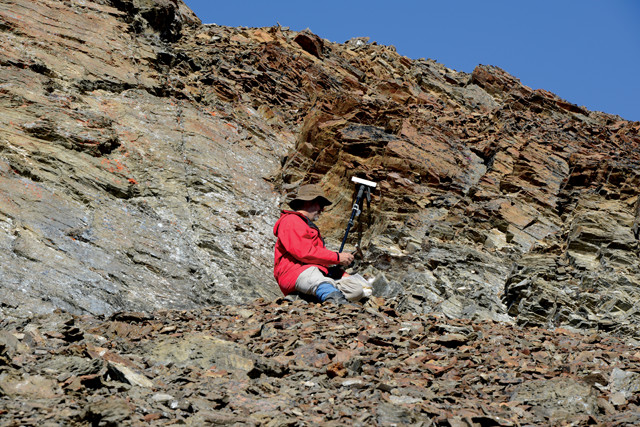
by Bethany Augliere Tuesday, November 15, 2016

Stephen Grasby collects samples from an outcrop on northern Ellesmere Island in the Canadian High Arctic. Credit: John Spear, Colorado School of Mines.
After Earth’s most severe mass extinction, life took up to 9 million years to recover — millions of years longer than after other extinction events. New research published in Geology suggests that a collapse in the ocean’s productivity might have been the cause.
The largest of Earth’s mass extinctions, called the Great Dying Event, occurred about 252 million years ago, just before the Permian and Triassic boundary. Roughly 96 percent of marine life and 70 percent of terrestrial life vanished, likely due to massive volcanic eruptions in Siberia that lasted for a million years and led to a major disruption in the global climate system, including significant warming. “So, the question is: What factors were inhibiting this recovery of life?” says Stephen Grasby, a geologist at the University of Calgary in Alberta, Canada, and lead author of the new study.
Grasby and a team of scientists traveled to the coast of Sverdrup Basin in the Canadian High Arctic, which has exposures of rock formed by marine sediments from the Late Carboniferous to the Cretaceous. The region represents what would have been the northwestern coast of the supercontinent Pangea, an area of high marine productivity, similar to the coasts of California or Argentina today. The team sought to measure key ocean nutrients from that time and examine how they changed during the recovery.
First, they had to collect rock samples. Grasby and the others climbed down gullies and carried up backpacks full of rocks. “We hauled hundreds of pounds of rocks out of there,” he says. At the lab, they used mass spectrometry to analyze 446 samples and measure their ratios of nitrogen isotopes, amounts of phosphorus and other elements known to occur in areas of high productivity, including barium, copper and nickel.
Normally, microbes can extract nitrogen from seawater, but if there isn’t any nitrogen in the water, certain types of microbes can extract it from the atmosphere. “It’s the sign of a very nutrient-stressed environment when there is no more nitrogen in the water, and so the only source left is from atmospheric nitrogen,” Grasby says. “The fingerprint for that stress is a change in the nitrogen isotope ratios.”
To analyze the isotopic ratios, the scientists compared the relative amounts of heavy and light stable nitrogen isotopes, nitrogen-15 and nitrogen-14 respectively, to atmospheric nitrogen, which is used as the standard and has a defined value of 0 per mil (one part per thousand). They found that the isotopic ratios went from positive values, nearly 10 per mil before the extinction, to almost zero through the Early Triassic, which is a signature of a nutrient-stressed environment. “These very low nitrogen isotope values suggest that it was a very nitrogen-starved ocean,” Grasby says. Phosphorus and other nutrients declined as well and paralleled the increasing sea-surface temperatures that have been reported in other studies.
“Something was limiting the nutrients in the upper part of the ocean,” he says. The authors suggest that global warming from the volcanic activity caused a warmer and more stratified ocean, which trapped nutrients in the deepwater. These nutrients couldn’t reach the sunlit surface, where phytoplankton live. “If you don’t fertilize your lawn, it’s going to get progressively more stressed over time,” Grasby says. Without phytoplankton serving as the base of the food web, complex life ceased.
After 5 million to 9 million years, the ocean cooled, stratification ceased, upwelling was reestablished and nutrients could cycle back to the surface. Soon thereafter, an explosion of life filled ecosystem voids created by the extinction, Grasby says. “This is when dinosaurs first evolved,” he adds.
This reduction in nutrients, which few people have looked at, is one important piece of the larger puzzle of understanding what happened after the extinction, says David Kidder, a geologist at Ohio University who was not involved in the study. In general, he says, there was a systemic shift in how Earth was functioning in terms of its climate and oceanography, such as levels of oxygen and sulfide in the water, Kidder says. But, he says, “it’s hard to put your finger on any single factor and say, ‘This was the cause of the extinction or the lack of recovery.'”
© 2008-2021. All rights reserved. Any copying, redistribution or retransmission of any of the contents of this service without the expressed written permission of the American Geosciences Institute is expressly prohibited. Click here for all copyright requests.